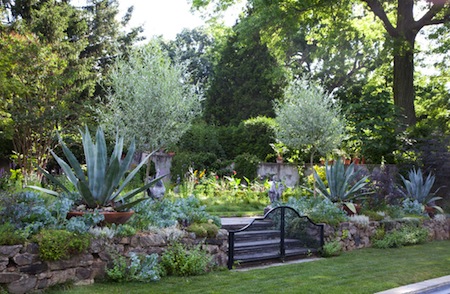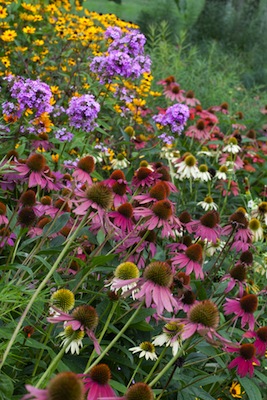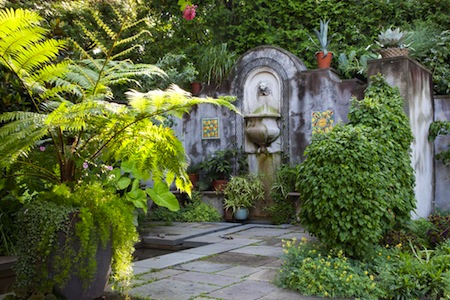Chanticleer: Visit the Garden, Read the Book
By Marsha Goldberg, Fairfax Master Gardener
If there were a Miss America Pageant for gardens, Chanticleer would win my vote for Ms. Personality, hands down. If you are unfamiliar with Chanticleer, consider visiting this nirvana for plants and enriching the experience by reading The Art of Gardening, written by Chanticleer’s staff. Located in Wayne, Pa., on Philadelphia’s Main Line, Chanticleer could be the perfect weekend retreat for you and your partner or an enjoyable destination with gardening friends.
Chanticleer is the former estate of the family of Adolph Rosengarten Sr., who built the home as a summer haven. (For you classic movie buffs, Chanticleer’s property borders the former home of Helen Hope Montgomery Scott, who served as the inspiration for Katherine Hepburn’s character in The Philadelphia Story.) During World War II, Rosengarten’s son, Adolph Jr., was stationed at Bletchley Park in London, famous for its work in breaking German code, where he fell in love with the classic English gardens. When he returned to Chanticleer, he implemented many of the same design ideas and eventually created a foundation to which he bequeathed the 38-acre estate upon his death in 1990. The garden opened to the public in 1993.
 The original Rosengarten house is open for tours, and a second house — which the elder Adolph gave to his daughter as a wedding present — is used for administrative offices. A third house, belonging to the younger Adolph, was in poor condition and not serving any function so the Foundation torn it down and, in its place, created “The Ruin,” built to look like the remnant of the grand home it once was. Surrounded by its own plantings, the iconic setting serves as the backdrop for numerous pieces of garden art and may remind visitors of The Secret Garden, in the children’s classic by Frances Hodgson Burnett.
The original Rosengarten house is open for tours, and a second house — which the elder Adolph gave to his daughter as a wedding present — is used for administrative offices. A third house, belonging to the younger Adolph, was in poor condition and not serving any function so the Foundation torn it down and, in its place, created “The Ruin,” built to look like the remnant of the grand home it once was. Surrounded by its own plantings, the iconic setting serves as the backdrop for numerous pieces of garden art and may remind visitors of The Secret Garden, in the children’s classic by Frances Hodgson Burnett.
Below the main house lies the tennis court garden, built on the former … you can probably guess! Filled with both perennials and annuals, it is an eye-popping display of color, rivaled only by the cutting garden further on. The path leads to the vegetable garden, Bell’s Woodland, Asian Woods, and numerous other exuberant displays. What gives Chanticleer its personality, however, is the contributions of the individual gardeners, and that is where the book, The Art of Gardening, becomes an invaluable resource. Rather than have R. William Thomas, Chanticleer’s executive director, author an entire book, he wrote only the introduction. The gardeners themselves wrote most of the text, each explaining the thinking that went into planning his or her section regarding color, design and succession planting. A wonderfully interesting and unexpected chapter explains what garden staff members do during the winter. Many of them have become woodworkers and welders, creating an astonishing array of garden art throughout the estate including iron gates, the designs of which reflect the plantings within them; benches, such as the one in the vegetable garden, rich with its carvings of pumpkins and other edibles; outdoor furniture made of bluestone slabs; and wooden furniture on which visitors can relax after taking in so much eye candy. The book can serve as a guide through the wonders of the garden or, when read as a stand-alone, can provide a plethora of valuable information and unique ideas that readers can use in their own gardens.
 While the gardeners each explain how they thought through and created their area, there are also later chapters about the trees, shrubs, bulbs, vines and climbers used throughout the estate, with explanations and helpful information about how the various plants are used and combined. The section on clematis discusses which types are vigorous growers and need a large space as well as those that are tamer, their different colors, and how to pair them with plants that can serve as their supports. The sections about roses and hydrangeas are similar in scope and provide details about their sizes, colors and habits. There is a section about the many ways that Chanticleer uses a variety of willows; I will soon be adding living willow fencing to my yard, now that I have learned what a useful plant this can be in the garden.
While the gardeners each explain how they thought through and created their area, there are also later chapters about the trees, shrubs, bulbs, vines and climbers used throughout the estate, with explanations and helpful information about how the various plants are used and combined. The section on clematis discusses which types are vigorous growers and need a large space as well as those that are tamer, their different colors, and how to pair them with plants that can serve as their supports. The sections about roses and hydrangeas are similar in scope and provide details about their sizes, colors and habits. There is a section about the many ways that Chanticleer uses a variety of willows; I will soon be adding living willow fencing to my yard, now that I have learned what a useful plant this can be in the garden.
If there is one thing that I would change at Chanticleer, it is the lack of labels on each individual plant. Chanticleer’s reason for doing this, however, makes sense. The Rosengarten family’s wish was that people who visit the garden feel like they are guests of the family. You can rock on the porch and look out at the vistas that the family enjoyed, or picnic on the grass. The gardeners feel that labeling the plants would take away from that ambience. Additionally, plants are changed often at Chanticleer, not just annually but seasonally. A garden that had hot reds and oranges in the spring might have cool greens and blues by late summer, so keeping all the plants labeled might be an impossible task. To address this issue, most of the individual gardens offer plant lists (contained in mounted boxes) that you can purchase for $2.00 or find online, for free, at http://chanticleergarden.org/. The lists include extensive information about the plants in each section, with pictures of some of the plants, as well as a master list with the source for each plant. The website information is a useful reference, although you would need to do the research to match the plants in the garden with the cultivars included on the printed materials.
A question might be whether to read the book first and then visit the garden, or visit the garden and then read the book. I did the latter but, truthfully, now that I have learned so much from reading the book, I would love to return. I think I would look at the garden with a different frame of reference. Lucky for me that my best gal pal lives in Philadelphia!